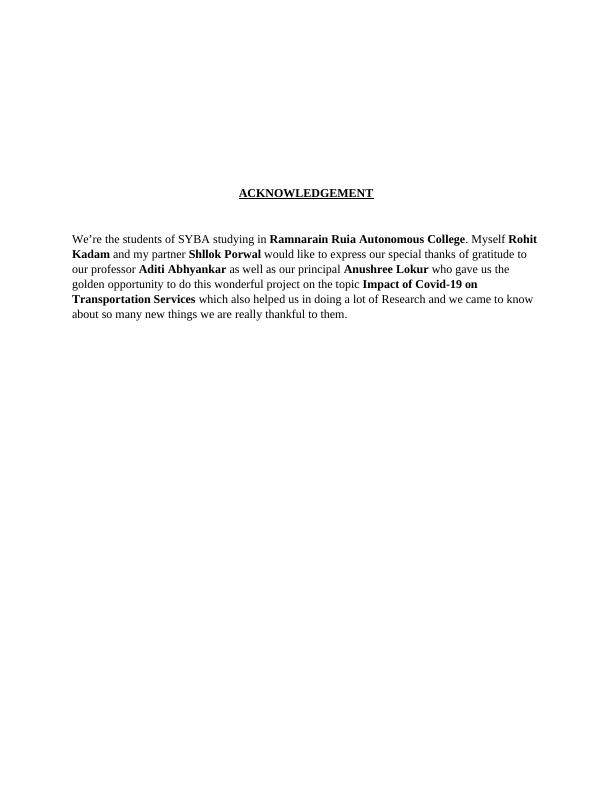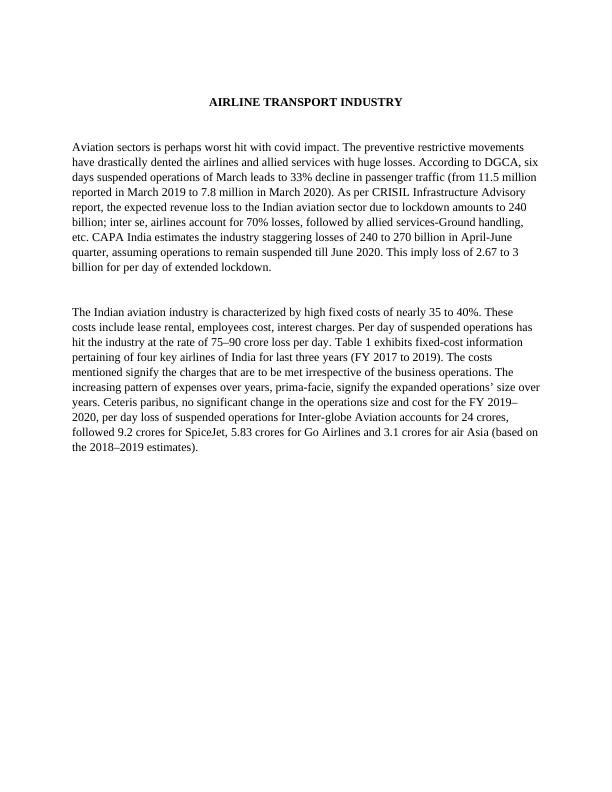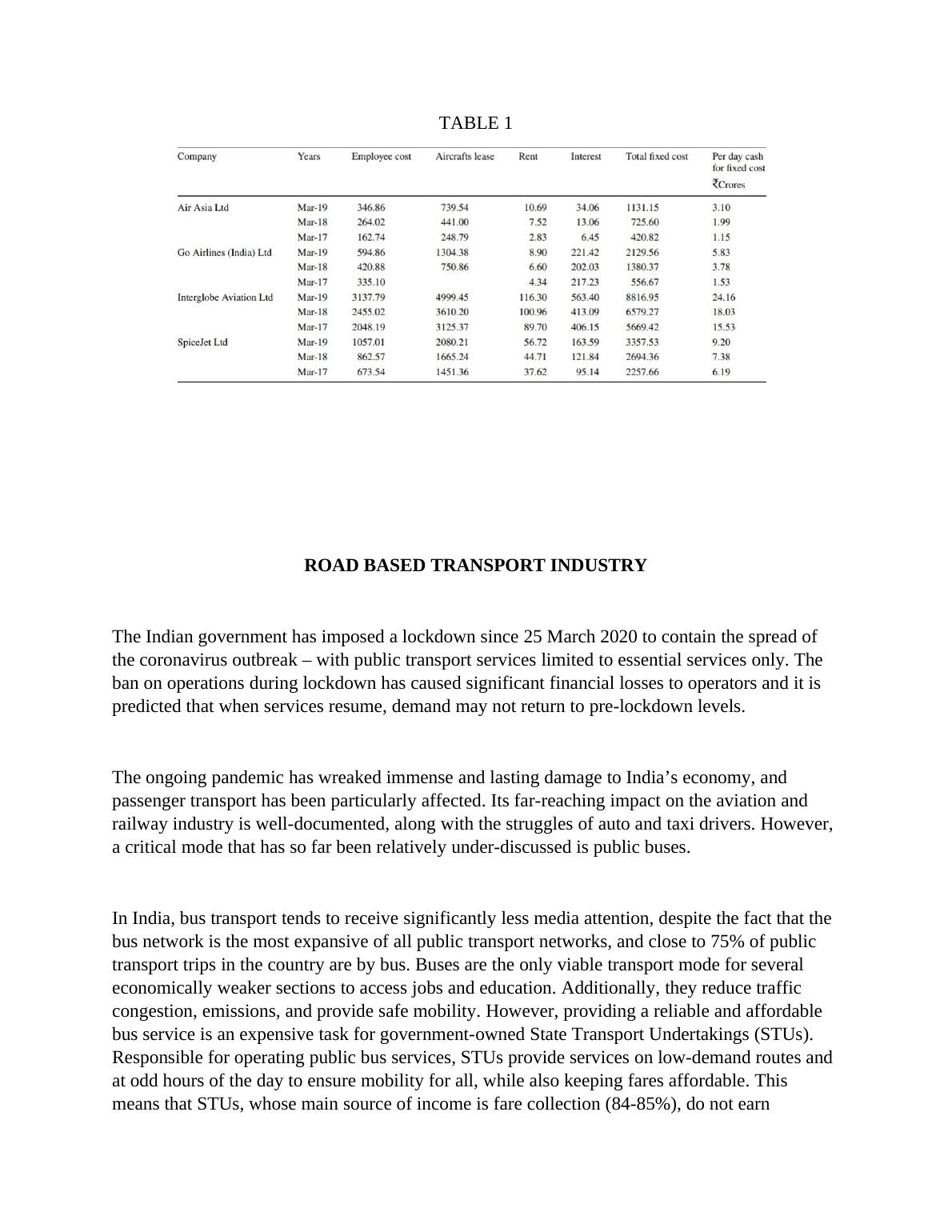(PDF) Impact of COVID-19 on Transportation Industry
Added on 2021-09-18
11 Pages2935 Words68 Views
Name: - Rohit Kadam, Shllok Porwal
Roll no: - 2326, 2352
Class: - SYBA
Division: - B
Subject: - Economics I
Topic: Effect of Covid 19 on Public transport
services in India
Semester III
Roll no: - 2326, 2352
Class: - SYBA
Division: - B
Subject: - Economics I
Topic: Effect of Covid 19 on Public transport
services in India
Semester III

ACKNOWLEDGEMENT
We’re the students of SYBA studying in Ramnarain Ruia Autonomous College. Myself Rohit
Kadam and my partner Shllok Porwal would like to express our special thanks of gratitude to
our professor Aditi Abhyankar as well as our principal Anushree Lokur who gave us the
golden opportunity to do this wonderful project on the topic Impact of Covid-19 on
Transportation Services which also helped us in doing a lot of Research and we came to know
about so many new things we are really thankful to them.
We’re the students of SYBA studying in Ramnarain Ruia Autonomous College. Myself Rohit
Kadam and my partner Shllok Porwal would like to express our special thanks of gratitude to
our professor Aditi Abhyankar as well as our principal Anushree Lokur who gave us the
golden opportunity to do this wonderful project on the topic Impact of Covid-19 on
Transportation Services which also helped us in doing a lot of Research and we came to know
about so many new things we are really thankful to them.

AIRLINE TRANSPORT INDUSTRY
Aviation sectors is perhaps worst hit with covid impact. The preventive restrictive movements
have drastically dented the airlines and allied services with huge losses. According to DGCA, six
days suspended operations of March leads to 33% decline in passenger traffic (from 11.5 million
reported in March 2019 to 7.8 million in March 2020). As per CRISIL Infrastructure Advisory
report, the expected revenue loss to the Indian aviation sector due to lockdown amounts to 240
billion; inter se, airlines account for 70% losses, followed by allied services-Ground handling,
etc. CAPA India estimates the industry staggering losses of 240 to 270 billion in April-June
quarter, assuming operations to remain suspended till June 2020. This imply loss of 2.67 to 3
billion for per day of extended lockdown.
The Indian aviation industry is characterized by high fixed costs of nearly 35 to 40%. These
costs include lease rental, employees cost, interest charges. Per day of suspended operations has
hit the industry at the rate of 75–90 crore loss per day. Table 1 exhibits fixed-cost information
pertaining of four key airlines of India for last three years (FY 2017 to 2019). The costs
mentioned signify the charges that are to be met irrespective of the business operations. The
increasing pattern of expenses over years, prima-facie, signify the expanded operations’ size over
years. Ceteris paribus, no significant change in the operations size and cost for the FY 2019–
2020, per day loss of suspended operations for Inter-globe Aviation accounts for 24 crores,
followed 9.2 crores for SpiceJet, 5.83 crores for Go Airlines and 3.1 crores for air Asia (based on
the 2018–2019 estimates).
Aviation sectors is perhaps worst hit with covid impact. The preventive restrictive movements
have drastically dented the airlines and allied services with huge losses. According to DGCA, six
days suspended operations of March leads to 33% decline in passenger traffic (from 11.5 million
reported in March 2019 to 7.8 million in March 2020). As per CRISIL Infrastructure Advisory
report, the expected revenue loss to the Indian aviation sector due to lockdown amounts to 240
billion; inter se, airlines account for 70% losses, followed by allied services-Ground handling,
etc. CAPA India estimates the industry staggering losses of 240 to 270 billion in April-June
quarter, assuming operations to remain suspended till June 2020. This imply loss of 2.67 to 3
billion for per day of extended lockdown.
The Indian aviation industry is characterized by high fixed costs of nearly 35 to 40%. These
costs include lease rental, employees cost, interest charges. Per day of suspended operations has
hit the industry at the rate of 75–90 crore loss per day. Table 1 exhibits fixed-cost information
pertaining of four key airlines of India for last three years (FY 2017 to 2019). The costs
mentioned signify the charges that are to be met irrespective of the business operations. The
increasing pattern of expenses over years, prima-facie, signify the expanded operations’ size over
years. Ceteris paribus, no significant change in the operations size and cost for the FY 2019–
2020, per day loss of suspended operations for Inter-globe Aviation accounts for 24 crores,
followed 9.2 crores for SpiceJet, 5.83 crores for Go Airlines and 3.1 crores for air Asia (based on
the 2018–2019 estimates).

TABLE 1
ROAD BASED TRANSPORT INDUSTRY
The Indian government has imposed a lockdown since 25 March 2020 to contain the spread of
the coronavirus outbreak – with public transport services limited to essential services only. The
ban on operations during lockdown has caused significant financial losses to operators and it is
predicted that when services resume, demand may not return to pre-lockdown levels.
The ongoing pandemic has wreaked immense and lasting damage to India’s economy, and
passenger transport has been particularly affected. Its far-reaching impact on the aviation and
railway industry is well-documented, along with the struggles of auto and taxi drivers. However,
a critical mode that has so far been relatively under-discussed is public buses.
In India, bus transport tends to receive significantly less media attention, despite the fact that the
bus network is the most expansive of all public transport networks, and close to 75% of public
transport trips in the country are by bus. Buses are the only viable transport mode for several
economically weaker sections to access jobs and education. Additionally, they reduce traffic
congestion, emissions, and provide safe mobility. However, providing a reliable and affordable
bus service is an expensive task for government-owned State Transport Undertakings (STUs).
Responsible for operating public bus services, STUs provide services on low-demand routes and
at odd hours of the day to ensure mobility for all, while also keeping fares affordable. This
means that STUs, whose main source of income is fare collection (84-85%), do not earn
ROAD BASED TRANSPORT INDUSTRY
The Indian government has imposed a lockdown since 25 March 2020 to contain the spread of
the coronavirus outbreak – with public transport services limited to essential services only. The
ban on operations during lockdown has caused significant financial losses to operators and it is
predicted that when services resume, demand may not return to pre-lockdown levels.
The ongoing pandemic has wreaked immense and lasting damage to India’s economy, and
passenger transport has been particularly affected. Its far-reaching impact on the aviation and
railway industry is well-documented, along with the struggles of auto and taxi drivers. However,
a critical mode that has so far been relatively under-discussed is public buses.
In India, bus transport tends to receive significantly less media attention, despite the fact that the
bus network is the most expansive of all public transport networks, and close to 75% of public
transport trips in the country are by bus. Buses are the only viable transport mode for several
economically weaker sections to access jobs and education. Additionally, they reduce traffic
congestion, emissions, and provide safe mobility. However, providing a reliable and affordable
bus service is an expensive task for government-owned State Transport Undertakings (STUs).
Responsible for operating public bus services, STUs provide services on low-demand routes and
at odd hours of the day to ensure mobility for all, while also keeping fares affordable. This
means that STUs, whose main source of income is fare collection (84-85%), do not earn

End of preview
Want to access all the pages? Upload your documents or become a member.
